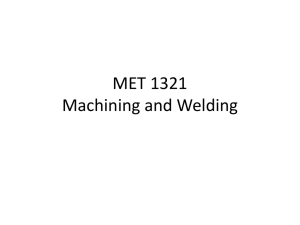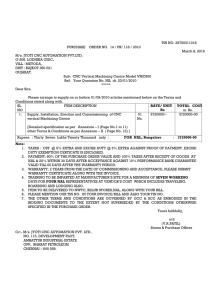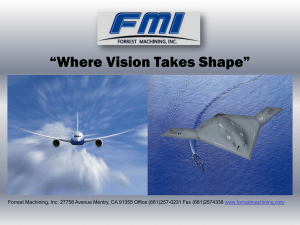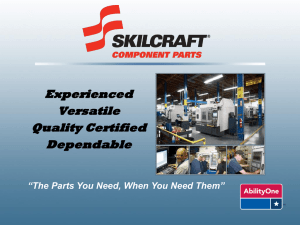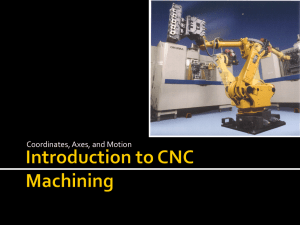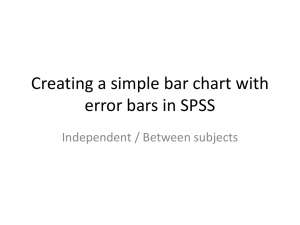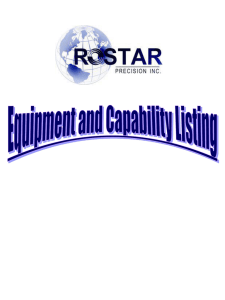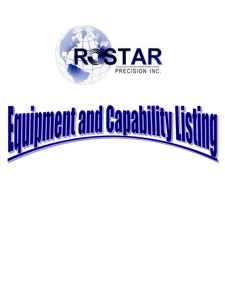13181 kB
advertisement
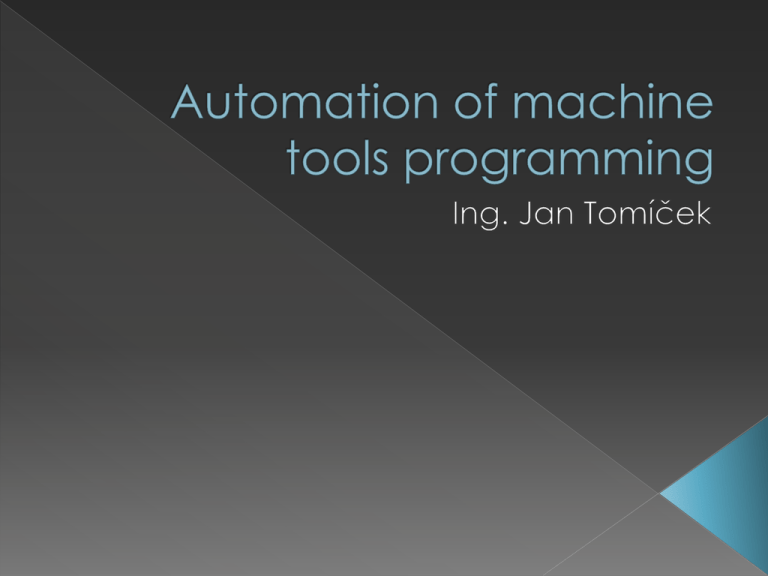
Course is focused fundamental possibilities of automatization of machine tools and automatization of programme preparation for CNC machine tools. 1+2, CA – classified assessment - 3 credits Presentations Exercises › common tasks › individual work 1+2, 1 hour of presentation, 2 of exercise => 13 + 13 weeks (13+26) => 4 + 9 approx.(12+27) presentation explain the work on exercise => presentation will be together on the beginning and then you will have time to make the task and individual work! Work on conventional machines is replaced by automated work on automatic machines. These machines are working without human control with higher speed, precision, safer and more productivly than humans. But where did it start? Is connected with the rising demands of society and industry development. Is the way to intensification of manufacturing – increasing productivity, improving quality and lowering costs Is the way to improvements in manufacturing technology, spreading the technological possibilities and way to make the inovation cycle faster. Tool management Tool change Tool movements Spindle start, devices start Material loading Finished piece remove Machine tools: general-purpose, manually operated (conventional); - The leading power is the worker Machine tools: automated: a) fixed automation – mechanisms: cams, gear wheels, links, levers, arms; mechanical stops, limit switches, etc. b) flexible automation – program control, numerical control Is a disc or cylinder with a curve shaped path. A boss in support is in the path and as the cam turns the support moves. Cam are connected together to provide complex movement of support, feed, rotation and other. automatic general-purpose machine e.g. a semiautomatic or an automatic lathe single-purpose machine (usually unit-built) workpiece oriented function design transfer line integrated workpiece transport system Just one operation, of op. Step is done. Sometimes a batch of operation steps Special machine designed to maximize the production: › Multiple spindles › High feed drives › Multiple clamping › Automatic part in feed › Special tooling usage Video – Transfer line (soft, programable automation) is aimed at piece and small batch production due to easy reprogramming. Two basic forms Program sequence control Numerical control The sequence of motions and switchings is controlled by relays, timers, switches, perforated tape, programable cylinders, plugboards and other controllers. Easier reprogramming, limited program options, almost no adjustments Each line presents a different movement or switch. It has to be printed correctly, no error control. FYI: 8 line perforated paper tape can contain one byte of information in one column of holes. Normal pitch of columns is 2,54 mm. That means you need 2,6 m of tape to store 1kB of data. A dual-layer DVD is then approx. 22100 km of perforated tape. The most important type of automation. Almost all of new machines are numerically controlled. Priciple: Machine and all of its movements are controlled by a program. Program is a list of instructions written is specific syntax and having specific format. Limitations – speed, length of program, possible motions on cams. 1. Conventional machine tool 2. NC machine tool (stand-alone) 3. NC machine tool with tool magazine 4. CNC machine tool Mechanization – human power is replaced by machines, drives, hydraulic or mechanic devices Automation – human control is replaced by sequentional machine, cams, computer, PLC controller Semiautomatic run – tools are changed automatically, blank or finished workpiece is renowed by operator Automatic run – both the tool and pieces are placed and removed automatically by robot (line, tables) Automatic Semiautomatic Tool management Tool change Tool movements Spindle start, devices start Material loading Finished piece remove Originaly only NC control was used. Program was stored on tape or disc and read one line after another. Influence of rapid development of computers resulted to CNC control (Computer numerical control). Now the program is loaded into computers memory and executed from here. Option NC control CNC control Program length Limited by data storage capacity (tape) Unlimited (limited by data storage capacity – HDD drives over 1TB) Program sequence One line after another Allows jump forward, backward, subprograms. Jump to other programs N/A Yes Canned cycles N/A Yes Coordinates correction Manually only Yes, automatically Tool length compensation Manually only Yes, programable Tool diameter compensation N/A Yes, programable Reading in advance N/A Yes, continual mode Start after breakdown N/A Yes NC/CNC machine consist of 3 basic elements. List of instructions – NC code – a mix of alphabecial and numerical information. Contaion information about movements, feed, speed, tool change and other machine functions (cooling, measuring) Control unit - control system – converts the program into signal for machine and send them to machine (PLC controller) NC code Control unit (system) Machine Drive motor Sensing device NC/CNC machine consist of 3 basic elements. Machine tool – fitted with drive motor to operate slides, support and spindle. Also with switches to start/stop specific functions Sensing device – optional(closed circuit)- sensing device control if a specific demand was fullfilled. Support feed, Table position etc. NC code Control unit (system) Machine Drive motor Sensing device Three types of motion 1) point-to-point motion – tool is moved to specific location, path or speed of move between location is not controlled. (drilling) 2) Linear control – movement along one of the axes of the machine. 3) Contouring control – movement can be made in two or more axes simultaneously. Point-to-point control drilling Linear control Contouring control (continual) milling machines, lathes machining c.(milling, turning) MC combine a number of different machining processes in one operation All manufacturers around the world Basic concept: 1) Holder with standadized conecting part – ISO, BSK cone, CAPTO system etc. 2) Extension bar – active (vibration elimination) adujstable and balanced 3) Quick change tooltip/insert Device used for transportation of blank and semiproduct in production Types: Belt conveyor Pulley(rolls) conveyor Cradle conveyor Used for small parts and loose material Endless belt made of rubber, plastic particles, short boards (grids) For large solid parts and products Low force needed (gravity slide ways) Use of pallets Video – conveyor Board used for transportation Equiped with jigs and other positioning elements Together with pallete changer is used for automatic blank material loading and parts unloading aka Switch table 2-4 pallets in one machine Manual - Accumulation conveyor - - Accumulating pieces to balance production - Robot loading - For single standing, large production usage (common machine tools) - Line(conveyor) loading - For FMS and large batch production (special machine tools) Flexible manufacturing system for 4 types of automobile cylinder heads (GM 3801 – 3811) BZ 400 BZ 500 Other Reserve Flexible to suit various part variants 9 Flexible transfer machines (some incorporating BZ 400 machining centers), and 16 high-dynamic BZ 500 machining centers Completely automated Approximately 500,000 parts p.a. - Cam‘s FMS - CNC tools - Conventional tools - Cost reducing (per piece) Higher investments Speed improvement Productivity improvement Repeatability improvement Machining costs (Kc/pce) - Productivity (pcs/hour) Flexibility Programming of machine tools Machining on CNC machines is controled by a NC code. NC code is a list of instructions for the machine and also for the operator. Instruction are executed in time order. NC code must have a specific format so that the control system of machine is able to read it. The tool in machine is moving in workspace. The position of the tool is given by coordinates. We are using different coordinate systems. If we set some coordinates in NC code, the machine moves the tool to the specified place. Basic is orthogonal system Z Y X Z axis is usually axis of spindle a X axis is the working axis, or the longest! Z Y X Z axis is usually axis of spindle a X axis is the working axis – diameter!!! X Z To set the position we can add rotation along the axes. Second set of coordinates U,V,W resp. P,Q,R etc. Z C Y B X A Refernce point – a specific point on machine with given coordinates. Not always in the workspace of machine. A special commang G98 Ways how to define a movement a) Absolute programing – position is in all point expressed as a distance from zeropoint b) Incremental programing – position is expressed as a change from last postion 2. 3. 1. Absolut G90 X0 Y0 Z50 2. G0 X15 Y70 Z50 G1 X15 Y70 Z0 3. G1 X25 Y70 Z0 G0 X25 Y70 Z50 1. G0 X0 Y0 Z50 Incremental G91 G0 X15 Y70 Z0 G1 X0 Y0 Z-50 G1 X25 Y0 Z0 G1 X0 Y0 Z50 G1 X-45 Y-70 Z0 Structure and form of NC code is standardized by international standard ISO 6983 – Numeric control programs formating Differences between different control system manufacturers and differences between versions. Lines (blocks) Words Word has a meaning and value part S 1500 ISO is standardized code (G – code) Some manufacturers devoloped their own standard for NC code – native standard Mazak – Mazatrol Heidenhein – iTNC Siemens - Sinumeric Heading lines Definition of relation between coordinate system of CNC machine and program, type of programing, work mode, working conditions Program body Cutting and non-cuting moves, main program and subprograms, tool changes Ending lines Tool return to home point, change to first tool, coordinates reconstruction Subprograms A link to another then the following line is entered into main programm. This subprogram is executed. After finishing this program we return to main program a we contiue until end of main program(M30) Manual/Hand programing Shopfloor programming Automated programing Editors are used. Program is written manually (by hand) line after line. Used for simple parts (but complex too) Toolpath is exactly defined Program can be adjusted to save time Can use canned cyles Can be parametrized Used in mass production We need to know the functions: (many more function exist) Movement functions: G00 rapid movement G01 linear interpolation/movement G02/03 circular interpolation G40 diameter compensation off G41 diameter compensation on /right handed G42 diameter compensation on /left handed Support and help functions: M06 tool change M03/04 spindle start CW/CCW M05 program stop M30 program end Specilzed editors Predator G-code editor G Wizard Mikronex Somewhere in between manual and automated Uses cycles with parameters We have to edit these parameters manually But the NC code is generated automatically No postprocessing Control system use – programming on machine - No costs (together with machine) - Fast use (macros) - Time waste (program x work) - Comfort (on machine x in office with PC) - Shape limitations Heidenhein Work with the „sequential NC code preparation“ Uses CAM (Computer Aided Manufacturing) software For all parts including complex shapes We dont need to compute the toolpath We need correct postprocessor Partprogram – workpiece, material, cutting conditions, tools… Procesor – according to technology CL data – virtual toolpaths on virtual machine Postprocesor – „translator“ for the specific CAMcontrol systém-machine combination NC code – toolpaths of a real tool on a real machine Partprogram Proceso r CL-data Postproceso r NC-kód is Computer Aided Manufacturing (machining) From simple 2-axis turning up to multiaxis machining Feature or technologically oriented Special types of CAM for special purpose Live presentation 2D – just in two axis - turning 2,5D – two axis, but in layers – not simultaneously 3D – three axes simultaneously multiaxis 4D – four axis - one rotary axis (rotary table) 5D – five axis - maching (two rotary axes) CAM software uses „Strategies“ Strategy – is a general plan how to move the tool durign machining Continual development Roughing – offset, raster (Zig-Zag method) plunging Finishing strategies – pencil milling, streaming, rest material maching NX (Siemens PLM software) Catia (Dassault systémes) – both 10% market share PowerMill, FeatureCAM, ArtCAM (Delcam company) ,InventorCAM (Autodesk) Wildfire – Pro/Ingineer (PTC) – 5% EdgeCAM, SurfCAM, SolidCAM, MasterCAM, OneCNC, ESPRIT, GibbsCAM Simulation is used to control generated toolpaths for following reasons: - Colisions - Undercuts (or rest material) - Postprocesing check NX We can do complex shapes, no need to calculate control points We can use simulation and verification We can change the tool easily But We need postprocessor Expensive (SW, computer, learning…) Program is always longer (again expensive) ArtCAM FeatureCAM Projects - Common – same tasks for all - Individual – own selection of part and individual work on it. Evaluated. Test – from theory of automation and programming



